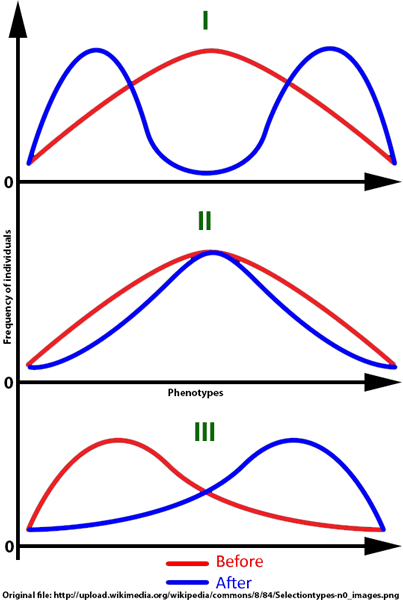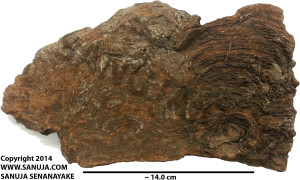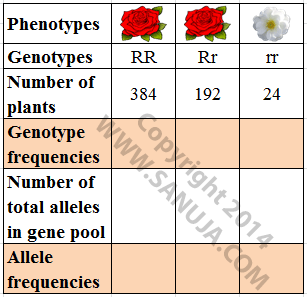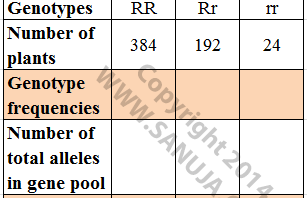Basic concepts: basic biological themes, hierarchy of organisms, diversity and domains, genetics and evolution, adaptations, fossil record and early life, geology, reproduction, genome and speciation.
Disclaimer: While every reasonable effort is made to ensure that the information provided is accurate, no guarantees for the currency or accuracy of information are made. It takes several proof readings and rewrites to bring the quiz to an exceptional level. If you find an error, please contact me as soon as possible. Please indicate the question description because server may randomize the questions and answers.
Go to: Midterm II | Midterm III | Final Exam
Biology 205 (BIOL 205-UCAL) Midterm I
Congratulations - you have completed Biology 205 (BIOL 205-UCAL) Midterm I.
You scored %%SCORE%% out of %%TOTAL%%. With incorrect multiple attempts your score is %%PERCENTAGE%%
Your performance has been rated as %%RATING%%
Question 1 |

Modified from: http://upload.wikimedia.org/wikipedia/commons/8/84/Selectiontypes-n0_images.png
A | I. Stabilizing selection II. Directional selection III. Disruptive selection |
B | I. Stabilizing selection II. Disruptive selection III. Directional selection |
C | I. Directional selection II. Disruptive selection III. Stabilizing selection |
D | I. Disruptive selection II. Stabilizing selection III. Directional selection |
E | I. Directional selection II. Stabilizing selection III. Disruptive selection |
F | I. Disruptive selection II. Directional selection III. Stabilizing selection |
Question 2 |
A | experimental process. |
B | inductive reasoning. |
C | scientific process. |
D | deductive reasoning. |
E | first-order reasoning or first order analysis. |
Question 3 |
A | mRNAs |
B | DNAs |
C | RNAs |
D | homeotic genes |
Question 4 |
A | Geographic speciation |
B | Reproductively isolated speciation |
C | Habitat speciation |
D | Polyploidy speciation |
Question 5 |
A | Heterozygote advantage |
B | Intra- and inter-sexual selection |
C | Continental drift |
D | Genetic drift |
Question 6 |
A | Dramatic reduction in salmon population due to excessive overfishing. |
B | Large variation in types of dogs (breeds) due to selective breeding. |
C | Genetically modified food such as bananas that converted wild inedible fruits to consumables. |
D | The better taste and large size of famed berries verses smaller wild berries. |
E | Human females choosing specific traits such as eye colour and height of donors when selecting sperm from a sperm bank. |
Question 7 |

A | eukaryotic cells |
B | bacteria |
C | stromatolites |
D | fungi |
Question 8 |
A | individual |
B | DNA |
C | population |
D | organ |
E | community |
Question 9 |
A | Gene flow |
B | Mutations |
C | Genetic drift |
D | Introduction of new species |
Question 10 |
A | ...eukaryotic cells with mostly macroscopic unicellular organisms. |
B | ...eukaryotic cells with mostly macroscopic multicellular organisms. |
C | ...prokaryotic cells with mostly macroscopic muticellular organisms. |
D | ...prokaryotic cells with mostly microscopic unicellular organisms. |
E | ...prokaryotic cells with mostly macroscopic unicellular organisms. |
F | ...eukaryotic cells with mostly microscopic unicellular organisms. |
Question 11 |
A | The total collection of genes in a kingdom at any one time. |
B | The total collection of genes in a population at any one time. |
C | The total collection of genes in a family at any one time. |
D | The total collection of genes in a species at any one time. |
Question 12 |
A | It is the process in which alleles are randomly selected for fertilization. |
B | It a process in which alleles from one population is transferred to another as a result of movement of individuals or gametes. |
C | It the process in which natural selection either modify, delete or replicate alleles from genes. |
D | It is the process in which RNA copy the DNA sequences and reproduce them by binding to proteins. |
Question 13 |
A | nitrogen |
B | water |
C | carbon dioxide |
D | ammonia |
E | hydrogen |
F | oxygen |
Question 14 |
A | The evolutionary mechanisms may have introduced a new alleles to the population that resist pesticide. |
B | The natural selection may have created new alleles that are resistant to pesticides. |
C | Some individuals in a particular pest population may have the pesticide resistant alleles. |
D | The environment in which the pest population live may have acted as a barrier to the pesticides' effectiveness. |
Question 15 |
A | Your great great (great....) grand parents must be nonhuman primates. |
B | These relationships between human and nonhuman primates demonstrate unity among all living organisms. |
C | nonhuman primates must have exchanged DNA with humans millions of years ago. |
D | The main statement in this question itself is the evidence that we all evolved from Africa. |
Question 16 |
A | Yes, because we can extrapolate the history from the type of sediments. |
B | No, because there is no useful evidence for the history without living or non-living (abiotic) organisms within the rock strata. |
C | Yes, because we can use radiometric dating of the sediments. |
D | No, because we use fossils record for age determination. |
Question 17 |
A | ecological |
B | phylogenetic |
C | morphological |
D | biological |
Question 18 |
A | A population study. |
B | An ecosystem study. |
C | A community study. |
D | Organisms study. |
Question 19 |
A | ...no natural selection. |
B | ...no gene flow between populations. |
C | ...very small population. |
D | ...random mating. |
E | ...no mutations. |
Question 20 |
A | 232 = 529 combinations |
B | 23/2 = 11.5 combinations |
C | 23 x 2 = 46 combinations |
D | 223 = 8.39 x 106 combinations |
E | 23 combinations |
Question 21 |
A | 50% or more |
B | 30% or more |
C | 90% or more |
D | 100% |
E | 10% or more |
Question 22 |
A | genetic drift |
B | genetic shift |
C | bottleneck effect |
D | evolution |
E | adaptation |
Question 23 |
A | ecosystem, population, organ system, cell, community, molecule, organ, organism, tissue |
B | cell, molecule, organ system, organ, tissue, population, organism, ecosystem, community |
C | cell, molecule, organ system, organ, population, tissue, organism, ecosystem, community |
D | molecule, cell, tissue, organ, organ system, organism, population, community, ecosystem |
E | molecule, tissue, cell, organ, organ system, organism, population, community, ecosystem |
Question 24 |
A | Plants and Animals |
B | Bacteria and fungi |
C | Plants and Eukarya |
D | Bacteria and Archaea |
E | Bacteria and Eukarya |
Question 25 |
A | A population in which whose members are genetically related to each other. |
B | A group of populations whose members have the potential to interbreed. |
C | A group of organisms whose members have the potential to reproduce either by sexual or asexual reproduction. |
D | A group of organisms living in the same community. |
Question 26 |
I. Polymerization of monomers
II. Replication of RNA molecules and passing of biological information from one cell to another.
III. Abiotic synthesis of important molecules from simpler chemicals in the atmosphere.
IV. Enclosure within a lipid membrane ("protocells"), which maintained a distinct internal environment.
A | III (first to occur) , I , IV , II (last to occur) |
B | III (first to occur) , IV , I , II (last to occur) |
C | I (first to occur) , III , IV , II (last to occur) |
D | I (first to occur) , IV , III , II (last to occur) |
E | III (first to occur) , I , II , IV (last to occur) |
F | I (first to occur) , III , II , IV (last to occur) |
Question 27 |
According to the following table, what are the genotype frequencies for all three possible outcomes?
Table 1: Gene pool of the original rose plants.Red is dominant and White is recessive.

A | RR = 0.62 , Rr = 0.30 , rr = 0.04 |
B | RR = 0.62 , Rr = 0.30 , rr = 0.08 |
C | RR = 0.64 , Rr = 0.32 , rr = 0.04 |
D | RR = 0.64 , Rr = 0.30 , rr = 0.08 |
E | RR = 0.60 , Rr = 0.32 , rr = 0.08 |
F | RR = 0.60 , Rr = 0.36 , rr = 0.04 |
Note that you divide possible number of genotypes by the total number of plants for the each frequency.
Question 28 |
A | Bacteria |
B | Cell |
C | Nucleus |
D | Nucleotide |
E | Organelle |
F | DNA |
Question 29 |
A | It is the process in which the current organism differentiate from its' ancestors. |
B | It is the process in which genetic mutation occur and lead to new forms of life. |
C | It is the process in which the dominant hunters eliminates another group of organisms. |
D | It is the process in which certain inherited traits are survived and reproduced than the other traits. |
E | It is a process in which a new forms of traits are developed into a phenotype (as opposed to just genotypes). |
Question 30 |
A | Eukaryotic cells are specialized cells while Prokaryotics cells can be specialized into any type of cell. |
B | Prokaryotics cells are the most common type of cells in the living world that made up of plants, animals and fungi. The Prokaryotics cells are only found in bacterias. |
C | Eukaryotic cells contain membrane-bound organelles, such as the nucleus, while prokaryotic cells do not. |
D | Eukaryotic cells are usually unicelluar and thought to be responsible for early life on Earth while Prokaryotics cells evolved later in the biological evolution. |
Question 31 |
A | I. Ecology II. genetic drift |
B | I. Biology II. genetic drift |
C | I. Biology II. natural selection |
D | I. Biology II. evolution |
E | I. Ecology II. natural selection |
Question 32 |
According to the following table, what are the allele frequencies in this gene pool (last row in the table, but remember, there are only two frequencies)?
Table 1: Gene pool of the original rose plants.Red is dominant and White is recessive.

A | R = 0.96 and r = 0.04 |
B | R = 0.37 and r = 0.63 |
C | R = 0.04 and r = 0.96 |
D | R = 0.63 and r = 0.37 |
E | R = 0.20 and r = 0.80 |
F | R = 0.80 and r = 0.20 |
Question 33 |
A | All the humans living in the City of Calgary. |
B | All the insects living in the entire world. |
C | All the dogs and cats living in the City of Calgary. |
D | All the insects living in the City of Calgary. |
E | All the birds living in the entire world. |
Question 34 |
A | The mating behavior of one species is completely different from the other. |
B | The new offspring have a weak immune system. |
C | The individual organisms are unable to produce a fertilized cell. |
D | The species live in different habitat within the same area and would not meet each other. |
Question 35 |
A | Diablo |
B | Pangaea |
C | Laurasia |
D | Gondwanaland |
Question 36 |
A | I. prokaryotes II. 4.3 billion |
B | I. eukaryotes II. 3.5 billion |
C | I. prokaryotes II. 3.5 billion |
D | I. eukaryotes II. 4.3 billion |
Question 37 |
A | Gene division and recombination |
B | Speciation |
C | Natural selection |
D | Evolution |
E | Sexual reproduction |
Question 38 |
A | The eye colour of humans. |
B | The amount of semen/sperms that will be ejected during an ejaculation by humans. |
C | The variation in depth of view in eyesight among humans. |
D | The number of brains humans could have. |
Question 39 |
On 26 December 2004, undersea megathrust earthquake West of Sumatra, Indonesia resulted in a Tsunami. The waves wiped out a population of cattle (cows) on the Eastern part of Sri Lanka. However, out of 2000 cattle, about 150 were able to escape death. Since the 2004 Tsunami, the cattle population has rebounded back to almost its original level. What is the major impact on the gene pool of the new generation of cattle after the Tsunami in this particular region?
A | The population is most likely experiencing bottleneck effect, where there is a drastic reduction in genetic variations. |
B | The new population most likely experiencing large scale genetic mutations due to limited partners for mating. |
C | The population most likely benefited from this catastrophic event because with reduce number of individuals, there is less competition for mating. |
D | The new population most likely will not survive for a long period without a gene flow between themselves and another unrelated population. |
E | The population is most likely underwent extremely fast evolution. |
Question 40 |
A | ...genetically isolated populations. |
B | ...very large populations. |
C | ...sexually reproducing populations. |
D | ...small populations. |
E | ....asxually reproducing populations. |
F | ...geographically isolated populations. |
Question 41 |
A | Adaptive radiation |
B | Founder effect |
C | Genetic drift |
D | Higher relative fitness |
E | Disruptive selection |
Question 42 |
A | ...how new species adapt and evolve. |
B | ...genetic variation caused by mass extinctions and repopulation cycles. |
C | ...the origins of life plus how new species adapt and evolve. |
D | ...the origins of life. |
Question 43 |
A | Nuclear energy released from binding of monomers. |
B | Nuclear energy from the remaining elements within the gas cloud from the original nebula. |
C | Frictional energy generated by plate tectonics in the deep sea. |
D | Thermal energy from the sun. |
E | Thermal energy from hydrothermal vents. |
Question 44 |
According to the following table, what is the total number of alleles in the gene pool?
Table 1: Gene pool of the original rose plants.Red is dominant and White is recessive.

A | 1200 |
B | 570 |
C | 660 |
D | 600 |
E | 500 |
Question 45 |
A | pq |
B | p2 |
C | 2q |
D | 2pq |
E | 2p |
Question 46 |
A | Sedimentary rocks |
B | Metamorphic rocks |
C | Igneous rocks |
D | Clastic rocks |
E | Punk rocks |
Question 47 |
A | ...the crust. |
B | ...the outer core. |
C | ...the outer layer. |
D | ...the mantle. |
Question 48 |
A | 2.1 bya |
B | 1.5 bya |
C | 4.6 bya |
D | 3.5 bya |
Question 49 |
A | It is the process which an organism enhances the probability of survival through acquired characteristics. |
B | It is the process in which organisms evolve. |
C | It is the process in which the new genes are produced in order to survive in a changing environment. |
D | It is an inherited characteristic that enhances an organism's ability to survive and reproduce in a particular environment. |
Question 50 |
A | It is a process in which the new species are created with completely independent (100% different) characteristics from that of the original species. |
B | It is the process in which two interbreeding individuals produce a zygote. |
C | It is the process in which one species splits into two or more species. |
D | It is the process in which DNAs react with other biochemicals to produce life. |
Question 51 |
A | Postzygotic barriers |
B | Prezygotic barriers |
C | Either because it is all depend on the type of organisms and their living environment. |
D | Neither because natural selection do not act at this level of life. |
Question 52 |
A | Because he assumed that inheritance traits can only be passed down to the offspring by the male population (fathers). |
B | Because he refused genetic variation within the same species. |
C | Because he assumed that inheritance traits also includes acquired characteristics. |
D | Because he refused that the environment also pays a vital role in evolution of desired traits. |
Question 53 |
A | I. potential to interbreed in nature II. fossils only. |
B | I. potential to interbreed in nature II. asexually and sexually reproducing organisms. |
C | I. DNA/chemical characteristics/traits II. asexually and sexually reproducing organisms. |
D | I. physical characteristics/traits II. fossils only. |
E | I. physical characteristics/traits II. asexually and sexually reproducing organisms. |
Question 54 |
A | ...by accumulating small changes over a a long period of time. |
B | ...by sexual reproduction at first and later by both sexual and asexual reproduction. |
C | ...through sudden changes in gene frequencies. |
D | ...by interbreeding. |
Question 55 |
A | Appendix |
B | Nails |
C | Spinal cord |
D | Hypothalamus |
Question 56 |
A | All the living organisms and their interaction among each other. |
B | An isolated system of organisms in which a specific population lives. |
C | A specific group of species, such as humans, living under a specific area and their interactions among living organisms. |
D | All the organisms in a specific area along with nonliving factors with which they interact. |
E | A specific area of study used to derive a hypothesis or a theory. |
Question 57 |
A | Ideas and concepts taken out of the book: Principles of Geology by Charles Leyell. |
B | The observation he made that all species will only produce offspring than the environment can support. |
C | Domesticated species like dogs in which humans have used artificial selection to produce animals with desirable traits. |
D | The observation he made that members of a population often vary in their inherited traits. |
Question 58 |
A | It can produce new genotypes that favors the entire global population of a species. |
B | It favors only the characteristics that benefit the specific population. |
C | It favors characteristics in a population that fit the current local environment. |
D | It can change the characteristics of a population in one of very few changes to the genetic code in a very short period of time. |
Question 59 |
A | Similarity in characteristics caused by convergent evolution is known as analogy, while similarity in characteristics caused by is sharing a common ancestor known as homology. |
B | Similarity in characteristics caused by one dominant allele is known as homology, while similarity in characteristics caused by two recessive alleles known as analogy. |
C | Similarity in characteristics caused by convergent evolution is known as homology, while similarity in characteristics caused by is sharing a common ancestor known as analogy. |
D | Similarity in characteristics caused by one dominant allele is known as analogy, while similarity in characteristics caused by two recessive alleles known as homology. |
Question 60 |
A | Human thumb and chimpanzee arm. |
B | Human limb and whale flipper. |
C | Oak leaf and maple leaf. |
D | Bat wing and insect wing. |
E | Oak leaf and oak root. |
Question 61 |
A | advanced civilization |
B | sexual reproduction |
C | evolutionary adaptations |
D | sudden specialization of DNA |
Question 62 |
According to the following table, what are the two possible number of total alleles for Rr in this gene pool?
Table 1: Gene pool of the original rose plants.Red is dominant and White is recessive.

A | 323 (R) + 61 (r) |
B | 131 (R) + 61(r) |
C | 61 (R) + 323 (r) |
D | 61 (R) + 131 (r) |
E | 192 (R) + 192 (r) |
Question 63 |
According to the following table, what is the total number of plants in this gene pool?
Table 1: Gene pool of the original rose plants.Red is dominant and White is recessive.

A | 216 |
B | 576 |
C | 600 |
D | 408 |
E | 500 |
Question 64 |
A | It is a conceptual model developed by a scientist before a research project is undertaken. |
B | It is a proposed explanation for a set of observations. |
C | It is a statement of facts supported by a large body of evidence. |
D | It is an idea which is still not been proven with a body of evidence. |
Question 65 |
A | Theory is similar to hypothesis but it covers a broader scope of the subject than a hypothesis. |
B | Theory can not be disproved with new evidence but hypothesis can be because hypothesis is a "working theory". |
C | Theory and hypothesis are two terms that can be used interchangeably (same or very similar meaning). |
D | Theory is used to describe fundamental principles of science while a hypothesis is used to describe first-order observable properties. |
E | Theory is similar to hypothesis but it covers a specific area of the subject than a hypothesis. |
← |
List |
→ |
| 1 | 2 | 3 | 4 | 5 |
| 6 | 7 | 8 | 9 | 10 |
| 11 | 12 | 13 | 14 | 15 |
| 16 | 17 | 18 | 19 | 20 |
| 21 | 22 | 23 | 24 | 25 |
| 26 | 27 | 28 | 29 | 30 |
| 31 | 32 | 33 | 34 | 35 |
| 36 | 37 | 38 | 39 | 40 |
| 41 | 42 | 43 | 44 | 45 |
| 46 | 47 | 48 | 49 | 50 |
| 51 | 52 | 53 | 54 | 55 |
| 56 | 57 | 58 | 59 | 60 |
| 61 | 62 | 63 | 64 | 65 |
| End |
Credits: Based on the excellent class notes provided by, Dr. K. Ruckstuhl during Fall 2014.
FAQ | Report an Error
You may download this exam as a PDF file here.
If you get a question wrong, you can still click on the other answers. This will open up hints and explanations (if available), which will provide additional information.
